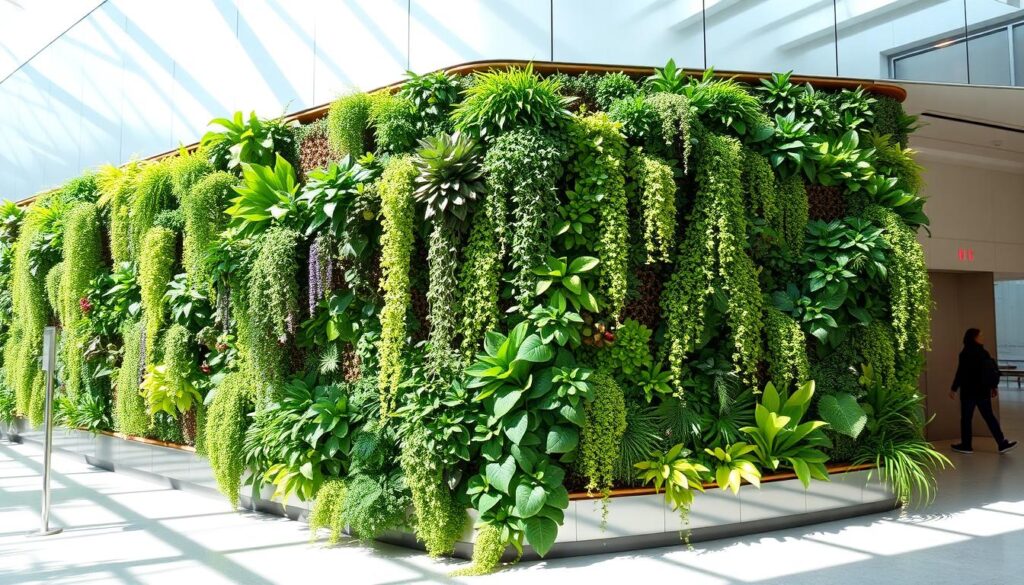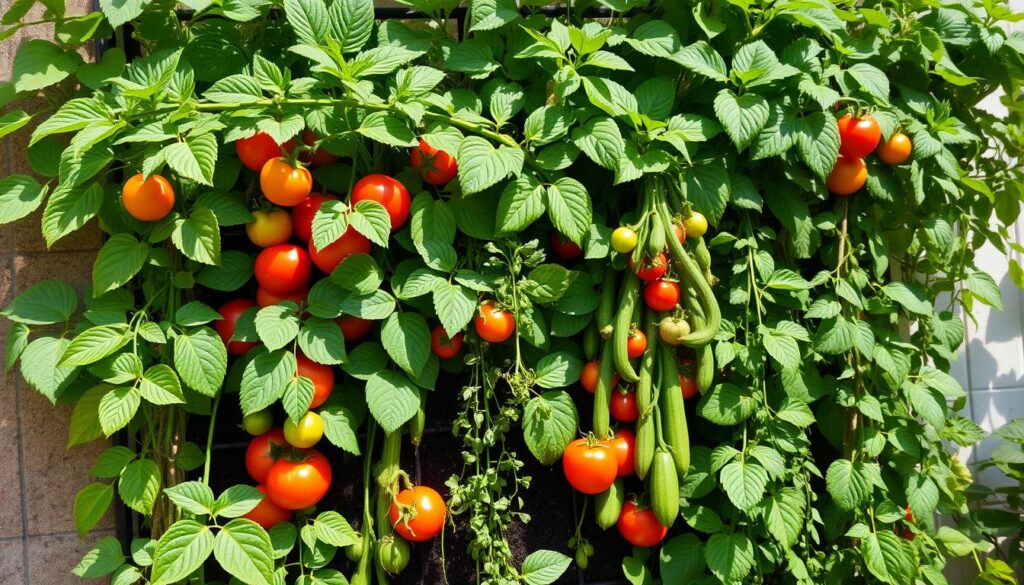As a gardener with a small backyard, I faced a big challenge. I wanted to use every inch wisely while keeping my plants healthy. Then, I found the magic of vertical gardening.
Vertical gardening changed my small garden into a lush, vibrant space. It lets me grow more plants in less space. This technique has brought amazing benefits, and I’m eager to share them with you.
Key Takeaways
- Vertical gardening maximizes limited garden spaces by growing plants vertically, increasing yields.
- Vertical gardens promote better air circulation, reducing the risk of common plant diseases.
- Vining, rambling, and sprawling plants thrive in vertical gardens, taking up less horizontal space.
- Vertical gardens allow for the efficient use of walls, trellises, and other structures to optimize space.
- Vertical gardening is a versatile solution for small gardens, urban settings, and indoor spaces.
Understanding Vertical Gardening Techniques
Vertical gardening is a smart way to use small spaces. It grows plants up, not out. This method uses trellises, walls, or fences to save space. It’s perfect for small gardens in the city.
What is Vertical Gardening?
Vertical gardening grows plants up, not out. It’s great for city gardens or small spaces. You can grow more plants in less space.
Benefits of Vertical Gardening
- Increased yields: You can grow more plants in a small area.
- Easier maintenance: Trellises and walls make it easier to care for plants.
- Reduced pest issues: Better airflow helps prevent pests and diseases.
- Enhanced sun exposure: Plants get more sunlight, leading to healthier growth.
Key Differences Between Vertical and Traditional Gardening
| Vertical Gardening | Traditional Gardening |
|---|---|
| Uses vertical space with structures like trellises or walls | Grows plants in rows or raised beds |
| Needs careful watering and nutrients due to vertical setup | Relies on natural water and nutrient flow |
| Requires strong support for plant weight and growth | Plants grow freely without needing much support |
Vertical gardening is a big change for city gardeners and those with small spaces. It offers many solutions and hacks. By learning about it, you can turn your small garden into a lush oasis.
Choosing the Right Plants for Vertical Spaces
Choosing the right plants is key for vertical gardening. You can grow high-yielding vegetables and vibrant flowers in vertical spaces. This way, you can have a lush and colorful garden, even in a small outdoor area.
Best Vegetables for Vertical Gardening
Vining vegetables like pole beans and climbing peas are great for vertical gardens. Tomatoes like ‘Sungold’ and ‘Black Cherry’ also grow well vertically. For cucumbers, ‘Burpee Hybrid II’ is a good choice.
Green bean fans should try ‘Romano Italian’. It produces lots of long, slender pods.
Flower Varieties that Thrive Vertically
Flowers like clematis and roses are perfect for vertical gardens. They can climb trellises or grow up walls. This adds elegance and interest to your space.
Smaller flowers like petunias and marigolds also do well vertically. They add color at eye level.
Herbs Perfect for Vertical Growth
Herbs like basil, oregano, and thyme are great for vertical gardens. They love the well-drained soil often found in vertical setups. These herbs can grow in small pots or hanging baskets, perfect for small areas.
By picking the right vegetables, flowers, and herbs, you can turn a small garden into a lush oasis. Try different vertical farming systems to find the best plants for your space.
Selecting Vertical Garden Structures
Choosing the right structures is key for a thriving vertical garden. You can pick from classic trellises to DIY solutions. These options help you make the most of small spaces and show off your gardening skills.
Trellises: A Supportive Solution
Trellises are a favorite in vertical gardening. They support climbing plants like beans, peas, and cucumbers. Made from bamboo, wood, or metal, they come in various styles to fit your garden.
For a space-saving idea, try stackable containers or stacked gardens. These designs are perfect for small gardens.
Vertical Planters: Options for Every Space
Wall-mounted planters, hanging baskets, and towers are great for small gardens. They let you grow many plants without using up ground space. This is perfect for a small outdoor area.
DIY Vertical Gardening Ideas
Get creative with DIY projects for vertical gardens. Use old ladders, window frames, or pallets to make unique spaces. Try living walls, gutter gardens, and more to make your small space green and efficient.
“Vertical gardening is a game-changer for small-space gardeners, allowing them to maximize their growing without losing ground area.”
When picking vertical garden structures, make sure they’re strong and well-attached. This way, your plants will thrive. By using different vertical gardening solutions, you can make the most of your small garden.
Maximizing Sunlight Exposure
Urban gardening needs creative ways to use small spaces. One key is to get more sunlight for your vertical gardens. Use the right spot and reflective surfaces to boost light in your garden.
Assessing Sunlight in Your Garden
Most veggies need 6-8 hours of direct sun a day. Watch how sunlight moves in your garden. This helps you place your vertical gardens for the best light.
Positioning Vertical Gardens for Optimal Light
Put your vertical gardens where they get the most sun, like the midday or west side. This helps plants absorb heat during the day. At night, the heat reflects back, helping plants grow faster.
Reflective Surfaces to Enhance Sunlight
In shady spots, reflective surfaces can help a lot. Try using mirrors, light walls, or shiny objects to bounce sunlight. This trick can greatly improve your garden’s health and yield.

Understanding sunlight’s role and using these tips can turn your small garden into a lush, productive space. You’ll get the most out of your vertical garden.
Effective Watering Techniques
Keeping your vertical garden moist is key to its success. Wall-mounted gardens might need more water because they’re exposed more. Using smart watering systems helps keep your plants healthy in small spaces.
Drip Irrigation Systems for Vertical Gardens
Drip irrigation systems are a big help for vertical gardens. They send water straight to the roots, saving water and keeping your garden moist. Adding timers makes watering automatic, saving you time and keeping plants hydrated.
Hand-Watering Tips for Vertical Settings
Hand-watering is great for those who like to get hands-on. Make sure to soak the roots well, avoiding water on the leaves. This stops fungi from growing.
Choosing Self-Watering Planters
Self-watering planters are easy to use for vertical gardens. They have reservoirs that slowly feed water to the soil. This keeps plants hydrated, which is good for vertical gardens where water can be hard to spread evenly.
| Watering Technique | Advantages | Considerations |
|---|---|---|
| Drip Irrigation |
|
|
| Hand-Watering |
|
|
| Self-Watering Planters |
|
|
Trying out these watering methods can help your vertical garden thrive. Find what works best for your space and your gardening style. Your plants will thank you.
Soil and Fertilization Best Practices
High-yield gardening starts with the right soil and fertilization. Choosing the best soil for your vertical garden is key. It affects your plants’ health and how much they grow.
Ideal Soil Mix for Vertical Gardens
For a thriving vertical garden, use a mix that drains well and is rich in nutrients. Add compost or well-rotted manure to boost fertility and hold water. This helps your plants get the nutrients they need in tight spaces. Stay away from heavy soils that can hold too much water and hurt root growth.
Fertilizer Types to Consider
- Slow-release fertilizers: These give nutrients over time, keeping your plants well-fed.
- Liquid fertilizers: These are quickly absorbed by plants. You can add them to the soil or spray them on leaves for a quick nutrient boost.
Regular Soil Maintenance Tips
- Top-dress your vertical gardens with compost or aged manure to add nutrients and improve soil.
- Check your soil’s pH levels and adjust as needed to keep it right for your plants.
- If your plants are in containers, change the soil mix every one to two years to keep nutrients flowing.
By focusing on soil and fertilization, you can make your vertical garden thrive. It will use your space well and give you lots of fresh, quality food.

“Healthy soil is the foundation for a successful vertical garden. With the right soil mix and regular maintenance, you can unlock the full potential of your small-space gardening efforts.”
Combating Pests and Diseases
Vertical gardening has many benefits, like better air flow and plants not touching the ground. But, gardeners might face pests and diseases. Knowing how to deal with these issues is important for a healthy vertical garden.
Common Pests in Vertical Gardens
Vertical gardens can attract pests like aphids, spider mites, and whiteflies. These pests harm plants by eating their leaves and stems. But, the air flow in vertical gardens makes it harder for pests to settle.
Natural Remedies for Pest Control
- Neem oil: This natural insecticide from the neem tree fights off many pests, including aphids and spider mites.
- Insecticidal soaps: These plant-based sprays can gently kill soft-bodied pests on plants.
- Introducing beneficial insects: Ladybugs, lacewings, and predatory mites can eat common garden pests.
Preventing Fungal Issues in Vertical Plants
Vertical gardening can also reduce fungal diseases. The better air flow stops moisture buildup that causes problems like powdery mildew or rust. To prevent fungal issues:
- Make sure plants are spaced right for good air flow.
- Regularly trim and care for your vertical garden to keep air moving.
- Place your vertical garden in sunny, breezy spots to stop fungal growth.
By tackling pests and diseases, urban gardeners and small-space fans can enjoy vertical farming’s benefits. They can keep their vertical gardens healthy and productive.
| Pest | Natural Remedy |
|---|---|
| Aphids | Neem oil, Insecticidal soap |
| Spider Mites | Neem oil, Insecticidal soap |
| Whiteflies | Neem oil, Insecticidal soap, Introducing beneficial insects |
Seasonal Planting Considerations
Understanding the seasons is key to a successful vertical garden. By matching your planting with the seasons, you’ll get a full harvest and beautiful displays all year.
Spring Planting Ideas for Vertical Gardens
When it gets warmer, it’s time to plant climbing veggies like peas and pole beans. These plants love to climb and do well in small spaces. Use trellises or cages to support them and make the most of your garden.
Summer Care for Vertical Plants
In summer, your garden needs regular water, picking, and pest checks. Use drip irrigation or water by hand to keep plants moist. Picking often helps plants grow more and keeps them from getting too crowded.
Preparing Your Vertical Garden for Winter
When winter comes, get your garden ready. Use frost cloths or move plants to safe spots. Some plants, like kale and herbs, can handle the cold. Plan your planting for your area’s climate to keep your garden thriving.
“Vertical gardening is a game-changer for small-space enthusiasts, allowing you to maximize your growing space and enjoy a full harvest all year.”
Creative Vertical Garden Design Ideas
Vertical gardening lets you turn small outdoor spaces into lush, vibrant spots. You can mix plants with different colors, textures, and growth habits. This way, you create stunning vertical garden designs that use every inch of space.
Color and Texture Combinations
Try mixing flowers, foliage, and trailing plants for depth and interest. Compact garden tulips can grow well in small plots with the right planning. Choose containers for tulips that are at least 12 inches deep for their roots.
For balcony tulip gardens, pick lightweight containers. This makes it easy to move them to sunny spots during the day.
Incorporating Art into Your Vertical Garden
Add artistic touches to your vertical garden. Rooftop gardens are perfect for tulips because they get lots of sunlight. Balcony tulip gardens use vertical planting to save space.
In urban gardens, group containers of different heights and styles. This creates a lush, eye-catching tulip garden.
Vertical Gardening in Urban Settings
Vertical gardening is great for those with little ground space. Katuk, a versatile plant, can turn tiny balconies into green oases. It’s perfect for small spaces or urban areas where ground space is scarce.
A vertical garden adds height and greenery, making a striking focal point. Use Katuk in container designs to make the most of small outdoor areas or urban settings. This enhances patios and decks.
“Vertical gardening is a revelation for maximizing small garden spaces. The creative possibilities are endless, from cascading blooms to living privacy screens.”
By using vertical gardening, you can turn small outdoor areas into vibrant, stunning spots. Whether it’s a balcony, small yard, or rooftop garden, think vertically and get creative with plants and design.
Sustainable Practices in Vertical Gardening
Vertical gardening is becoming popular for its space-saving benefits. It’s key to use sustainable practices to protect the environment and ensure success. By repurposing materials and saving water, gardeners can make a big difference. They also enjoy the benefits of growing a lot in a small space.
Using Recycled Materials for Structures
Using recycled items for vertical gardens is very eco-friendly. Items like wooden pallets, old gutters, or plastic bottles can be turned into strong supports. This not only cuts down on waste but also makes your garden unique and green.
Water Conservation Techniques
Water is precious, and vertical gardens can help save it. Mulching and choosing plants that don’t need much water are good ways to use less water. Also, installing systems to collect rainwater can help even more.
Benefits of Companion Planting
Vertical gardens are perfect for companion planting. This means placing plants together to help each other grow. For example, basil near tomatoes can keep pests away and make the tomatoes taste better. This natural method uses space well and avoids harmful chemicals.
By following these sustainable practices, gardeners can create beautiful, green spaces. These spaces not only save space but also help the planet. Whether you’re new to gardening or have been doing it for years, these tips will make your gardening more rewarding and eco-friendly.
Conclusion: Start Your Vertical Gardening Journey Today
Vertical gardening is great for making the most of small spaces. It uses special structures and picks plants that save space. This way, you can grow more in less room and make your garden look amazing.
Recap of Benefits
Vertical gardening helps you grow more food and takes less work. It’s perfect for city folks and those with little space. You can grow lots of veggies or colorful flowers and herbs. It turns your small area into a lush, productive spot.
Encouragement to Experiment with Vertical Gardening
Vertical gardening is all about trying new things. Begin with a few containers or a simple trellis. Then, grow your garden as you learn more. Try different setups and plants to see what works for you.
By exploring vertical gardening, you can make your small garden a beautiful, productive place. You’ll use every bit of space you have.
FAQ
What is vertical gardening?
Vertical gardening is a way to grow plants up, not out. It uses trellises, walls, or fences to save space. This method is great for small areas.
What are the benefits of vertical gardening?
It boosts harvests and makes gardening easier. You’ll have fewer plant problems and better air flow. It’s perfect for city gardens with little ground space.
How does vertical gardening differ from traditional gardening?
Vertical gardening uses space up, not out. It might need more water and strong supports. Plants grow up, not spread out.
What are the best plants for vertical gardening?
Good choices include pole beans, climbing peas, and sweet potatoes. Tomatoes, clematis, and roses are also great. Herbs like basil and thyme work well too.
What types of vertical structures can be used?
You can use trellises, arches, and pergolas. Wire cages and netting are also good. DIY projects include living walls and planters from pallets.
How can I ensure my vertical garden gets enough sunlight?
Place your garden to catch midday or afternoon sun. This helps plants grow faster. Use reflective surfaces to brighten shadier spots.
How do I water a vertical garden effectively?
Vertical gardens need more water, so water often. Drip systems with timers help. Water at the base and soak well. Self-watering planters are also helpful.
What soil and fertilization practices are best for vertical gardens?
Use soil that drains well and is rich in nutrients. Add compost or manure. Slow-release or liquid fertilizers are good for containers. Keep soil healthy with compost and pH checks.
How do I manage pests and diseases in a vertical garden?
Vertical gardens have fewer pests due to better air. But, pests like aphids can occur. Use natural pest control and avoid fungal issues by not overwatering.
What should I consider when planning a vertical garden for different seasons?
In spring, plant peas and pole beans. Summer needs regular watering and pest checks. For winter, use frost cloths or move plants. Kale and some herbs can grow in winter.


